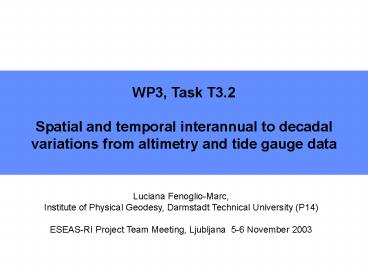folien PowerPoint PPT Presentation
1 / 20
Title: folien
1
WP3, Task T3.2 Spatial and temporal
interannual to decadal variations from altimetry
and tide gauge data
Luciana Fenoglio-Marc, Institute of Physical
Geodesy, Darmstadt Technical University
(P14) ESEAS-RI Project Team Meeting, Ljubljana
5-6 November 2003
2
TASK / DELIVERABLES / MILESTONES
(1.1)
TASK 3.2 a) Estimate dominating spatial and
temporal variations on interannual to decadal
time-scales (P2, P5, P14) b) ...and their
relationship with physical phenomena like El
Nino/La Nina (P2, P5, P14) c) Interpolate sparse
TG data to grids using EOF derived from satellite
altimetry (P2,P14) DELIVERABLES (contributes
with T3.3 to) D3.2 Global interpolated data set
of decadal variations from TG data using EOF
derived from T/P altimetry MILESTONES M3.2
EOF Analysis completed (18 month) M3.3
Empirical Model of decadal variability (with
T3.3)
3
1) Deliverable/Milestones 2) Input from previous
Task 3.1 3) Activities in this task 4)
Preparation to Tasks 3.3 and 3.4
4
(2..1)
Input from previous Task 3.1
1) Report on annual to decadal from tide gauge
data 2) Data 2.1) Quality controlled tide
gauge data monthly (hourly) 2.2) Decadal to
interannual part of tide gauge series 3) Report
on annual to decadal from altimetry 4) Data
4.1) Gridded monthly time series from altimetry
(1. X 1., 0.5 x 0.5) 4.1) Decadal to
interannual part of altimetric time series
5
(2.2)
Input from previous Task 3.1
H(P,t)_interannual H(P,t) - decadal(P)(t-to) -
seasonal(P,t_month)
Figure 1. First dominant component of interannual
to decadal field
6
(2.2)
Input from previous Task 3.1
Figure 2. First dominant component interannual to
decadal with 95 confidence level
7
Activities in Task 3.2 (3.1)l
1. Estimate spatial and temporal variation
2. Correlation with NAO and ENSO full field or
interannual field?
3. Interpolation in space and time of TG to
empirical function model estimated by satellite
altimetry (temporal spatial autocovariance)
Comparison of altimetry and tide gauge
(interannual part) 1.1 Spectra 1.2.
Autocovariance 1.2 Time series differences
Remark 1 comparison as external quality check
(altimetry versus in situ).
Remark 2 monthly and hourly data from TG
necessary
8
(3.2)
Activities in Task 3.2
0. Preliminary comparison of altimetry and tide
gauge (1)
Agreement of Spectra not always yes in
Hadera
Figure 1. Power Spectrum of interannual at Hadera
TG (left), nearest altimeter point (right)
9
(3.3)
Activities in Task 3.2
0. Preliminary comparison of altimetry and tide
gauge (2)
Agreement of Spectra not always not in Toulon
Figure 2. Power Spectrum of interannual in Toulon
TG (left), nearest altimeter point (right)
10
(3.4)
Activities in Task 3.2
0. Preliminary comparison of altimetry and tide
gauge (3)
Spectra of difference lenght
Comparison of spectra 100 years and 10 years at
TG
Figure 3. Power Spectrum of interannual in
Stockolm TG with 10 years (left), 100 years
(right)
11
(3.5)
Activities in Task 3.2
0. Preliminary comparison time series
differences (4)
Difference of time series monthly and hourly
Causes coastal variability, vertical land
motion, and also problems at stations
Figure 4. Difference of MONTHLYmeans and HOURLY,
full field
12
Activities in Task 3.2
(3.6)
0. Preliminary comparison time series
differences (5)
Ancona difference in trends? Toulon ok Les
Sables dOlonne Ocean tide in
Figure 5. Difference of MONTHLY full field
13
Activities in Task 3.2
(3.7)
0. Preliminary comparison time series
differences (6)
Fig. 6
- Italian Tide gauges are in general a jump in
summer 1998 - what to do with that? (26 tide gauge stations)
- Do not use them
- estimation of the bias using altimetry
Figure 5. Difference of MONTHLY full field
14
(3.8)
Activities in Task 3.2
1. EOF Decomposition (started in Task 3.1)
(T3.2a) Estimate dominating spatial and temporal
variations on interannual to decadal time-scales
SLA data in m x n matrix (from altimetry)
EOF (column vectors orthogonal, spatial maps)
Eigenvalues (diag.)
PCA (row vectors orthogonal, temporal
variability)
Linear combination of maps of spatially
correlated signals and associated time variations
SVD Singular Value Decomposition
15
(3.9)
EOF of NAAS interannual field, standardized
anomalies, 1 x 1 degree
16
(3.10)
EOF of NAAS complete field, standardized
anomalies, 1 x 1 degree
17
(3.11)
Activities in Task 3.2
2. Empirical models / Relationship with physical
phenomena
Modes do not have necessarily physical meaning
- Correlation Analysis between PCA mode
and SOI or NAO index
Figure 5. GMSL from TGR along with SOI (from
Chambers et al., 2002, Physics and Chemistry of
the Earth, 2002)
Figure 6. NAO index
18
EOF Reconstruction
(3.13)
3. Interpolate in space and time TG to altimetry
fields
(T3.2c) Interpolate sparse TG data to grids using
EOF derived from satellite altimetry (P2, P14)
SLA at TG (sparse observations), recentred
estimated parameters in LSQ
Reconstructed grids computed on the basis of the
estimated parameters
Recentred every 10 years trend eliminated in
TG trend NOT eliminated in altimetry (decadal
variability)
Static spatial maps
19
(4.1)
Preparation to T3.3, T3.4
T3.3 Inter-decadal T3.4 Secular trends
20
Summary
1) Interannual and decadal field from altimetry
has been constructed and EOF Analysis used to
estimate spatial and temporal variability from
altimetry at interannual and decadal (model of
interannual variability).
2) TG and altimetry have now to be compared
(power spectra, height differences of both
interannual and complete field) to finalise
results of Task 3.1 and start Task 3.2
3) Accuracy is estimated by statistical
comparison. Differences with altimetry should be
discussed and understood BEFORE interpolating TG
to grids of altimetry. Selection of tide gauges
to be used
4) Relation of statistical model of variability
with NAO and SOI (use EOF modes and ?)
5) The reconstructed time series at tide gauge
from the empirical model will be used to
propagate the high spatial resolution of
altimetry to longer time scales (in Task 3.3).
6) To distinguish decadal variability from
long-time trend is the challenge for the next
tasks T3.3 and T3.4!

